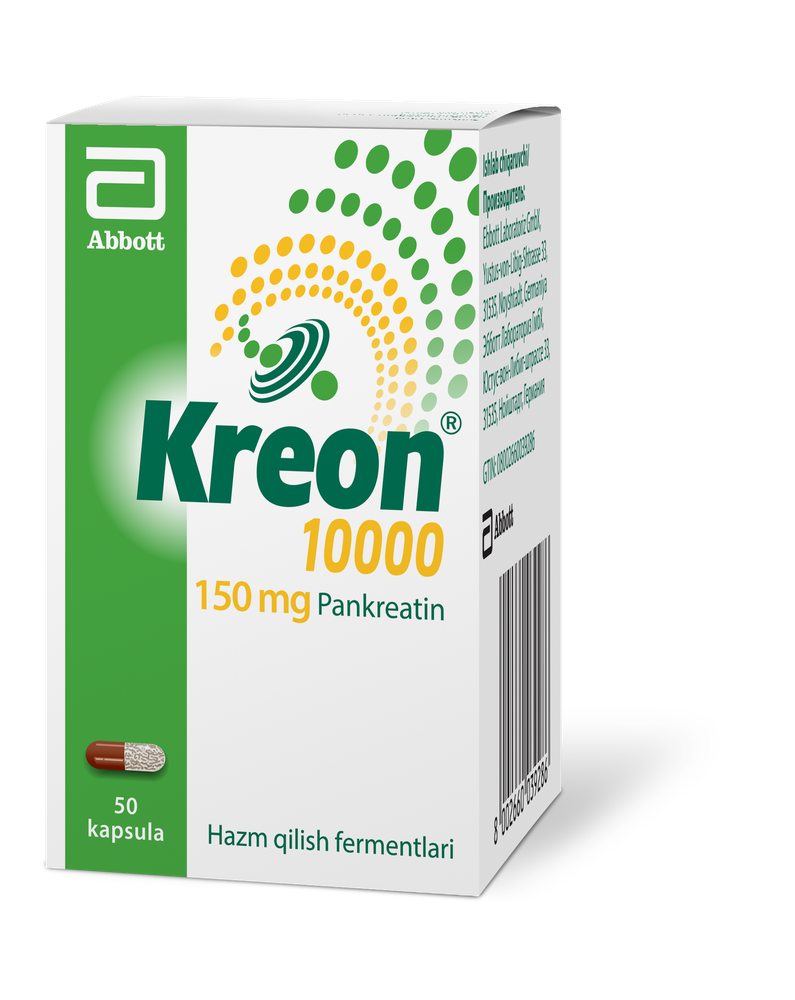

KREON CIK


How to use KREON CIK
INSTRUCTIONS FOR MEDICAL USE OF DEPRATAL MEDICINE
COMPOSITION
The active substance is duloxetine hydrochloride; 1 enteric-coated tablet contains duloxetine hydrochloride equivalent to 30 mg or 60 mg of duloxetine; excipients: pressed sugar, corn starch, magnesium stearate; shell composition: methacrylic acid-ethyl acrylate copolymer (1:1), 30% dispersion; triethyl citrate; talc; titanium dioxide (E 171); simethicone emulsion.
PHARMACEUTICAL FORM
Enteric-coated tablets.
MAIN PHYSICOCHEMICAL PROPERTIES
Dosage 30 mg: from white to almost white, round, biconvex, coated tablets, with engraving ')' on one side.
Dosage 60 mg: from white to almost white, round, biconvex, coated tablets.
PHARMACOTHERAPEUTIC GROUP
Other antidepressants. ATC code N06A X21.
PHARMACOLOGICAL PROPERTIES
PHARMACODYNAMICS
Duloxetine is a combined inhibitor of serotonin and norepinephrine reuptake. It slightly inhibits the uptake of dopamine and has no significant affinity for histamine and dopamine, cholinergic and adrenergic receptors. The mechanism of action of duloxetine in the treatment of depression is due to the inhibition of serotonin and norepinephrine reuptake, and, as a result, the enhancement of serotonergic and noradrenergic neurotransmission in the central nervous system (CNS). Duloxetine also has an analgesic effect, which is likely the result of slowing down the transmission of pain impulses in the CNS.
PHARMACOKINETICS
Absorption
After oral administration, duloxetine is well absorbed. The maximum concentration is reached 6 hours after administration of the drug. Food intake delays the absorption time, the time to reach the maximum concentration increases from 6 to 10 hours, while absorption decreases (by approximately 11%).
Distribution
Duloxetine is effectively bound to human plasma proteins (approximately 96%), both to albumin and to alpha-1-acid glycoprotein. Liver or kidney failure does not affect protein binding.
Metabolism
Duloxetine is metabolized with the participation of CYP2D6 and CYP1A2 isoenzymes. The metabolites formed are pharmacologically inactive.
Excretion
The half-life of duloxetine is approximately 12 hours. The average plasma clearance of duloxetine is 101 L/h.
PRECLINICAL SAFETY DATA
Duloxetine did not exhibit genotoxicity in a standard battery of tests and did not exhibit carcinogenicity in mice. Multinucleated cells were found in the liver in the absence of other histopathological changes in a mouse carcinogenicity study. The primary mechanism and clinical significance are unknown. In female mice that received duloxetine for 2 years, an increased frequency of hepatocellular adenomas and carcinomas was observed only at a high dose (144 mg/kg/day), but they were considered secondary to liver microsomal enzyme induction. The relevance of the data obtained in mouse studies to humans is unknown.
In a study in female rats that received duloxetine (45 mg/kg/day) before and during mating and early pregnancy, a decrease in food consumption by the mother and body weight, disruption of the estrous cycle, decreased birth rates and survival of offspring, as well as delayed growth of offspring at levels of systemic exposure estimated to be the highest at maximum clinical exposure (AUC). In a rabbit embryotoxicity study, a higher frequency of cardiovascular and skeletal developmental abnormalities was observed at levels of systemic exposure lower than the maximum clinical exposure (AUC). No developmental abnormalities were observed in another study where a higher dose of another duloxetine salt was tested. In prenatal/postnatal toxicity studies in rats, duloxetine caused adverse behavioral effects in offspring at doses below the maximum clinical exposure (AUC). Studies in young rats found a temporary effect on neurobehavior, as well as significant decreases in body weight and food consumption, induction of liver enzymes, and hepatocellular vacuolation at a dose of 45 mg/kg/day. The overall toxicity profile of duloxetine in young rats was similar to that in adult rats. The no-adverse-effect level of duloxetine was determined to be 20 mg/kg/day.
CLINICAL CHARACTERISTICS
INDICATIONS
Treatment of major depressive disorder.
Treatment of diabetic peripheral neuropathic pain.
Treatment of generalized anxiety disorder.
CONTRAINDICATIONS
A contraindication to the use of the drug is increased sensitivity to duloxetine or to any of the excipients of the drug.
Duloxetine should not be prescribed in combination with non-selective irreversible monoamine oxidase inhibitors (MAOIs).
Duloxetine should not be prescribed to patients with unstable hypertension, as this may provoke a hypertensive crisis.
Duloxetine should not be prescribed to patients with terminal stage renal failure (creatinine clearance <30 mL/min).
Duloxetine should not be prescribed to patients with liver disease - this may cause liver failure.
Duloxetine should not be prescribed in combination with fluvoxamine, ciprofloxacin, or enoxacin (strong CYP1A2 inhibitors) due to increased duloxetine plasma concentrations.
INTERACTIONS WITH OTHER MEDICINAL PRODUCTS AND OTHER TYPES OF INTERACTIONS
Medicinal products metabolized by CYP1A2. In a clinical study, when theophylline, a CYP1A2 substrate, was co-administered with duloxetine (60 mg twice daily), no significant pharmacokinetic interaction was observed.
CYP1A2 inhibitors. Since CYP1A2 is involved in the metabolism of duloxetine, concomitant use of duloxetine with potent CYP1A2 inhibitors is likely to result in increased duloxetine concentrations. Fluvoxamine (100 mg once daily), a potent CYP1A2 inhibitor, decreased duloxetine clearance by approximately 77%. Therefore, duloxetine should not be prescribed in combination with CYP1A2 inhibitors, including fluvoxamine.
Medicinal products metabolized by CYP2D6. Duloxetine is a moderate inhibitor of CYP2D6. When duloxetine was administered at a dose of 60 mg twice daily with a single dose of desipramine, a CYP2D6 substrate, the AUC of desipramine increased 3-fold. Concomitant administration of duloxetine (40 mg twice daily) increased the steady-state AUC of tolterodine (2 mg twice daily) by 71%, but did not affect the pharmacokinetics of the 5-hydroxy metabolite; therefore, no dose adjustment is recommended.
It is recommended to use duloxetine with caution in combination with medicinal products that are primarily metabolized by CYP2D6 (risperidone, tricyclic antidepressants, such as nortriptyline, amitriptyline, and imipramine), especially if they have a narrow therapeutic index (e.g., flecainide, propafenone, and metoprolol).
Central nervous system (CNS) active medicinal products. When duloxetine is prescribed in combination with other medicinal products or substances that act on the central nervous system, especially with a similar mechanism of action, including alcohol and sedative medicinal products (e.g., benzodiazepines, opioid analgesics, antidepressants, phenobarbital, sedative antihistamine preparations), certain precautions should be taken.
MAOIs. Duloxetine should not be prescribed in combination with non-selective irreversible MAOIs due to the risk of serotonin syndrome and at least 14 days after discontinuation of MAOI treatment. Given the half-life of duloxetine, MAOIs should not be prescribed for at least 5 days after discontinuation of duloxetine treatment. When taking reversible selective MAOIs, such as moclobemide or triptans, tramadol, pethidine, tryptophan, and buprenorphine, the risk of serotonin syndrome is lower, but the use of such a combination is not recommended. The antibiotic linezolid is a reversible non-selective MAOI; it should not be prescribed to patients taking duloxetine (see "Special warnings and precautions for use").
Oral contraceptives and other steroid agents: in vitro studies have shown that duloxetine does not induce catalytic activity of CYP3A. No specific in vivo interaction studies have been conducted.
Anticoagulants and anti-thrombotic agents. Duloxetine should be prescribed with caution in combination with oral anticoagulants and anti-thrombotic agents due to an increased risk of bleeding due to a pharmacodynamic interaction. Increased international normalized ratio (INR) values have been reported when patients taking warfarin started taking duloxetine. However, concomitant administration of duloxetine and warfarin in an inpatient setting in healthy volunteers during a clinical pharmacology study did not result in a clinically significant change in INR from baseline or in the pharmacokinetics of R- or S-warfarin.
Medicinal products containing duloxetine. It is necessary to avoid concomitant use with other medicinal products containing duloxetine.
Preparations containing St. John's Wort. Concomitant use with duloxetine often results in adverse reactions.
Antacids and H2 antagonists: concomitant administration of duloxetine with antacids containing aluminum and magnesium or duloxetine with famotidine did not affect the rate or extent of duloxetine absorption after oral administration of a 40 mg dose.
CYP1A2 inducers: pharmacokinetic analyses showed that smokers have approximately 50% lower duloxetine plasma concentrations compared to non-smokers.
SPECIAL WARNINGS AND PRECAUTIONS FOR USE
Seizures and mania. Duloxetine should be prescribed with caution to patients with a history of seizures, mania, or bipolar disorders.
Mydriasis. There have been reports of mydriasis associated with duloxetine use, so duloxetine should be prescribed with caution to patients with increased intraocular pressure or at risk of acute narrow-angle glaucoma.
Blood pressure and heart rate. In some patients, duloxetine treatment may lead to increased blood pressure. This may be related to the noradrenergic effect of duloxetine. Hypertensive crisis has been reported with duloxetine, especially in patients with arterial hypertension. Patients with arterial hypertension and/or other heart diseases should be monitored for blood pressure, especially during the first month of treatment. Duloxetine should be used with caution in patients who may have cardiac rhythm disturbances or increased blood pressure. Duloxetine should also be used with caution in combination with medicinal products that may worsen its metabolism (see "Interactions with other medicinal products and other types of interactions"). Patients with persistently elevated blood pressure should reduce the dose or discontinue the drug. Treatment of patients with unstable hypertension is not recommended.
Renal impairment. Elevated duloxetine plasma concentrations have been observed in patients with terminal stage renal failure who are on continuous hemodialysis (creatinine clearance <30 mL/min). Regarding patients with terminal stage renal failure, see "Contraindications"; regarding patients with mild or moderate renal impairment, see "Posology and method of administration".
Serotonin syndrome and malignant neuroleptic syndrome. Treatment with duloxetine may cause potentially life-threatening serotonin syndrome or malignant neuroleptic syndrome, especially when used in combination with other serotonergic agents (including selective serotonin reuptake inhibitors (SSRIs), selective norepinephrine reuptake inhibitors (SNRIs), tricyclic antidepressants, or triptans), agents that impair serotonin metabolism, such as MAOIs, antidepressants, or other dopamine antagonists that may affect serotonergic and/or dopaminergic neurotransmitter systems.
Serotonin syndrome may include altered mental status (e.g., agitation, hallucinations, coma), autonomic instability (e.g., tachycardia, labile blood pressure, hyperthermia), neuromuscular abnormalities (e.g., hyperreflexia, incoordination), and/or gastrointestinal symptoms (e.g., nausea, vomiting, diarrhea).
In its most severe form, serotonin syndrome can resemble malignant neuroleptic syndrome, the symptoms of which include, among others, hyperthermia, muscle rigidity, elevated creatine kinase levels in serum, autonomic instability with possible rapid changes in vital signs, and altered mental status.
If concomitant treatment with duloxetine and other serotonergic agents and/or neuroleptics that may affect serotonergic and/or dopaminergic neurotransmitter systems is clinically justified, the patient should be closely monitored, especially at the beginning of treatment and when increasing the dose.
If serotonin syndrome is suspected, the possibility of reducing the dose or discontinuing treatment should be considered, depending on the severity of symptoms.
Bleeding. Abnormal bleeding, such as ecchymoses, purpura, gastrointestinal bleeding, and hemorrhages, have been reported with SSRIs and SNRIs, including duloxetine. The drug should be prescribed with caution to patients taking anticoagulants and/or medicinal products that affect platelet function (e.g., non-steroidal anti-inflammatory drugs or acetylsalicylic acid), as well as to patients with a tendency to bleeding. Duloxetine increases the risk of postpartum hemorrhage (see "Pregnancy and lactation").
Hyponatremia. Hyponatremia, including cases with serum sodium levels below 110 mmol/L, has been reported with duloxetine treatment. Hyponatremia may be caused by the syndrome of inappropriate antidiuretic hormone secretion (SIADH). Most of these cases were reported in elderly patients, especially with a history of hyponatremia or conditions that may lead to changes in fluid balance. The drug should be prescribed with caution to elderly patients, patients with cirrhosis, and patients with dehydration or patients taking diuretics.
Withdrawal syndrome. Withdrawal symptoms occur quite frequently, especially after sudden discontinuation of treatment (see "Adverse reactions"). In clinical trials, adverse reactions that occurred after discontinuation of treatment were observed in approximately 45% of patients who received duloxetine and 23% of patients who received placebo.
The risk of withdrawal symptoms with SSRIs and SNRIs depends on several factors, including the duration of therapy and dosage, as well as the rate of dose reduction. These symptoms are usually mild or moderate, but in some patients, they can be severe. They usually appear within the first few days after discontinuation of treatment, but very rare reports of such symptoms have been reported in patients who accidentally missed a dose. Usually, these symptoms are limited and disappear within 2 weeks, although in some individuals, they may be prolonged (2-3 months or more). Therefore, it is recommended that discontinuation of duloxetine treatment be gradual, over a period of at least 2 weeks, according to the patient's needs.
Akathisia/psychomotor agitation. Duloxetine treatment has been associated with the development of akathisia, characterized by subjective, unpleasant psychomotor agitation and a need to move, often accompanied by an inability to sit or stand still. This phenomenon occurs within the first few weeks of treatment. For patients who develop these symptoms, increasing the dose may be harmful.
Hepatitis/elevated liver enzymes. Cases of liver damage, including significant elevations in liver enzymes (up to 10 times above normal), hepatitis, and jaundice, have been reported with duloxetine (see "Adverse reactions"). Most of these events occurred within the first month of treatment. Liver damage was most commonly hepatocellular in nature. Duloxetine should be prescribed with caution to patients taking medicinal products that may cause liver damage.
Sexual dysfunction. SSRIs and SNRIs may cause symptoms of sexual dysfunction (see "Adverse reactions"). Prolonged sexual dysfunction has been reported, where symptoms persisted despite discontinuation of SSRIs and/or SNRIs.
Presence of sucrose. Enteric-coated tablets of Deparat should not be prescribed to patients with hereditary fructose intolerance, malabsorption syndrome, or sucrase-isomaltase insufficiency.
Suicidality. Major depressive disorder and generalized anxiety disorder. Depression is associated with an increased risk of suicidal thinking, self-harm, and suicide (suicidality). The risk exists until significant improvement is achieved. Patients should be closely monitored until significant improvement is achieved, as improvement may not occur within the first few weeks of treatment or more. It is known from clinical experience that the risk of suicide increases at the beginning of treatment.
Other mental disorders for which duloxetine is prescribed may also be associated with an increased risk of suicidal behavior. In addition, these mental disorders may be comorbid if they accompany major depressive disorder. Therefore, the same precautions should be taken when treating patients with major depressive disorder and other mental disorders. In patients with a history of suicidal behavior or significant suicidal ideation, the risk of suicidal behavior is higher, so closer monitoring is required during treatment. A meta-analysis of placebo-controlled clinical trials of antidepressants in mental disorders showed an increased risk of suicidal behavior when taking antidepressants compared to placebo in patients under 25 years of age.
Suicidal thoughts and suicidal behavior have been reported during treatment with duloxetine or shortly after discontinuation of treatment.
During treatment, especially at the beginning of treatment and after changing the dose, patients should be closely monitored, especially those at high risk. Patients (and their caregivers) should be informed about the need to monitor for any clinical worsening, suicidal behavior, or unusual changes in behavior and to seek medical attention immediately if such symptoms occur.
Diabetic peripheral neuropathic pain. There have been reports of suicidal thoughts and suicidal behavior during treatment with duloxetine or immediately after discontinuation of treatment, as well as with other medicinal products with similar pharmacological action (antidepressants). Doctors should inform patients about the need to report any feelings of concern.
USE IN CHILDREN AND ADOLESCENTS (UNDER 18 YEARS OF AGE)
Duloxetine should not be used to treat children and adolescents (under 18 years of age). Suicidal behavior (suicide attempts and suicidal thoughts) and hostility (mainly aggression, oppositional behavior, and anger) were more frequently observed in clinical trials in children and adolescents who received antidepressants compared to those who received placebo. If, considering the clinical need, a decision is made to treat, the patient should be closely monitored for the emergence of suicidal symptoms. Additionally, there are no long-term data on the safety of children and adolescents regarding growth, maturation, and cognitive and behavioral development (see "Adverse reactions").
ELDERLY PATIENTS
Data on the use of Deparat in a dose of 120 mg in elderly patients with major depressive disorder and generalized anxiety disorder are limited. Therefore, caution should be exercised when treating elderly patients with the maximum dose.
USE DURING PREGNANCY OR BREASTFEEDING
PREGNANCY
Animal studies have demonstrated reproductive toxicity when systemic exposure (AUC) to duloxetine was less than the maximum clinical exposure (see "Preclinical safety data").
The results of two large observational studies (one conducted in the United States involving 2500 women and one conducted in the European Union involving 1500 women who took duloxetine during the first trimester of pregnancy) do not indicate an increased overall risk of serious congenital malformations. Analysis of specific malformations, such as heart defects, did not yield conclusive results.
In a study conducted in the European Union, the use of duloxetine by pregnant women in late pregnancy (at any time from 20 weeks of gestation to delivery) was associated with an increased risk of preterm birth (nearly 2-fold, corresponding to approximately 6 additional preterm births per 100 women). Most preterm births occurred between 35 and 36 weeks of gestation. In a study conducted in the United States, such an association was not observed.
Data from observations in the United States show an increased risk (nearly 2-fold) of postpartum hemorrhage when duloxetine was used during the month before delivery.
Epidemiological data suggest that the use of SSRIs during pregnancy, especially in late pregnancy, increases the risk of persistent pulmonary hypertension in newborns.
Although no studies have investigated the link between the risk of persistent pulmonary hypertension and SSRI treatment, this potential risk cannot be excluded with duloxetine, given the related mechanism of action (inhibition of serotonin reuptake).
As with other serotonergic medicinal products, symptoms of withdrawal may occur in newborns shortly after maternal use of duloxetine. These symptoms may include hypotonia, tremor, agitation, difficulty feeding, respiratory distress, and seizures. In most cases, withdrawal symptoms occurred either at birth or within a few days after birth.
Medicinal products containing duloxetine should be used during pregnancy only if the potential benefit justifies the potential risk to the fetus. Women should be advised to inform their doctor if they become pregnant or plan to become pregnant during treatment.
BREASTFEEDING
Duloxetine is weakly excreted into breast milk. The established dose for a child, based on a dose of 1 mg per 1 kg of body weight, is approximately 0.14% of the maternal dose. The safety of duloxetine in children is unknown; therefore, breastfeeding is not recommended during treatment with duloxetine.
FERTILITY
In animal studies, duloxetine did not affect male fertility. Effects in females appeared only at doses that caused toxicity to the mother.
ABILITY TO INFLUENCE REACTION RATE WHEN DRIVING VEHICLES OR OPERATING MACHINERY
No studies have been conducted on the effect of duloxetine on reaction rate when driving vehicles or operating machinery. The use of duloxetine may be associated with sedation and dizziness. During treatment, patients may experience a sedative reaction or dizziness. In such cases, patients should avoid potentially hazardous activities that require increased attention and psychomotor reaction rates.
POSOLGY AND METHOD OF ADMINISTRATION
For major depressive disorder. The initial and recommended maintenance dose is 60 mg once daily, regardless of food intake.
The safety of dosing from 60 mg once daily to a maximum dose of 120 mg daily has been evaluated in clinical trials. However, there are no clinical data to suggest that patients who do not respond to the initial recommended dose may benefit from dose increases.
The therapeutic effect of treatment is evident within 2-4 weeks.
After consolidating the response to antidepressant treatment, it is recommended to continue treatment for several months to prevent relapse. For patients who respond to duloxetine and have a history of recurrent major depressive episodes, further long-term treatment should be considered at a dose of 60-120 mg daily.
For generalized anxiety disorder, the recommended initial dose is 30 mg once daily, regardless of food intake. If the effect is insufficient, the dose should be increased to 60 mg daily, which is the usual maintenance dose for most patients. For patients with comorbid major depressive disorder, the recommended initial and maintenance dose is 60 mg once daily (see also the dosage recommendations above).
In clinical trials, doses up to 120 mg were shown to be effective and safe. Therefore, for patients with an insufficient response to a dose of 60 mg, a dose increase to 90 mg or 120 mg can be considered. Dose increases should be based on clinical response and tolerability.
After achieving a therapeutic effect, it is recommended to continue treatment for several months to prevent relapse.
For diabetic peripheral neuropathic pain, the recommended initial dose is 60 mg once daily, regardless of food intake. Some patients may be recommended to increase the dose up to a maximum of 120 mg daily, divided into two doses. This dosing has been evaluated for safety in clinical trials. Duloxetine plasma concentrations show significant individual variability. Therefore, some patients who do not respond to a dose of 60 mg may benefit from a higher dose.
The therapeutic effect of treatment is evident within 2 months.
In patients with an inadequate initial response, further dose increases after this time are unlikely to be beneficial.
Therapeutic benefits should be evaluated regularly (at least every 3 months).
Patients with renal impairment. Dose adjustment is not required for patients with mild or moderate renal impairment (creatinine clearance 30-80 mL/min). For patients with terminal stage renal failure (creatinine clearance <30 mL/min), this medicinal product is contraindicated.
Patients with hepatic impairment. Deparat should not be prescribed to patients with liver disease.
Elderly patients. It is not necessary to adjust the dose of the drug when prescribing to elderly patients. However, as with any medicinal product, when treating elderly people, especially when using duloxetine 120 mg daily for major depressive disorder or generalized anxiety disorder, for which data are limited (see "Special warnings and precautions for use"), Deparat should be used with caution.
DISCONTINUATION OF TREATMENT
It is necessary to avoid sudden discontinuation of the drug. When discontinuing duloxetine treatment, the dose should be gradually reduced over a period of at least 1 to 2 weeks to minimize the risk of withdrawal symptoms (see "Special warnings and precautions for use" and "Adverse reactions"). If, after reducing the dose or after discontinuation of treatment, intolerable symptoms occur, it is recommended to consider restoring the previously established dose. Subsequently, the doctor may continue to gradually reduce the dose, but at a slower rate.
CHILDREN
The medicinal product is not used in pediatric practice.
OVERDOSAGE
Symptoms. Cases of overdose have been reported with duloxetine doses of 5400 mg as monotherapy or in combination with other medicinal products. Several fatal cases have been reported, mainly with mixed overdose, but there have also been fatal cases with duloxetine alone at a dose of approximately 1000 mg. Signs and symptoms of overdose (duloxetine alone or in combination with other medicinal products) included somnolence, coma, serotonin syndrome, seizures, vomiting, and tachycardia. Symptoms of overdose (mainly with concomitant use of other medicinal products) included somnolence, coma, serotonin syndrome, epileptic seizures, vomiting, and tachycardia.
Specific antidotes are unknown; in case of serotonin syndrome, specific treatment is necessary (cyproheptadine and/or temperature control). It is necessary to check the patency of the airways. Monitoring of cardiac activity and control of vital functions, along with appropriate symptomatic and supportive measures, is recommended. Gastric lavage may be useful if performed immediately after ingestion of the medicinal product or for symptomatic purposes. Activated charcoal reduces the absorption of the medicinal product. Duloxetine has a large volume of distribution in the body, so forced diuresis, hemoperfusion, and exchange perfusion are unlikely to be beneficial.
ADVERSE REACTIONS
The most commonly reported adverse reactions were dizziness, nausea, and headache, dry mouth, and somnolence as unfavorable symptoms when taking duloxetine. However, most adverse reactions were mild or moderate, they usually started at the beginning of treatment, and most of them disappeared, even if treatment was continued. The table lists adverse reactions that were observed with duloxetine, based on data from spontaneous reports and placebo-controlled clinical trials.
| Very common | Common | Uncommon | Rare | Very rare | Frequency not known |
| Infections and infestations | |||||
| Laryngitis | |||||
| Endocrine disorders | |||||
| Hypothyroidism | |||||
| Immune system disorders | |||||
| Anaphylactic reactions, hypersensitivity | |||||
| Metabolic disorders | |||||
| Decreased appetite | Hyperglycemia (especially in patients with diabetes) | Dehydration, hyponatremia, ADH deficiency | |||
| Psychiatric disorders | |||||
| Insomnia, agitation, decreased libido, anxiety, abnormal vision, and abnormal orgasm | Sleep disorders, bruxism, disorientation, apathy, suicidal thoughts, suicidal behavior | Mania, hallucinations, aggressive behavior, and anger | |||
| Nervous system disorders | |||||
| Headache, somnolence | Tremor, paresthesia, dizziness, lethargy | Myoclonus, akathisia, nervousness, attention disorders, dyskinesia, taste disorders, restless legs syndrome, poor sleep | Serotonin syndrome, seizures, psychomotor agitation, extrapyramidal disorders | ||
| Eye disorders | |||||
| Blurred vision | Mydriasis, vision disorders | Glaucoma | |||
| Ear and labyrinth disorders | |||||
| Tinnitus | Dizziness, ear pain | ||||
1 Seizures and tinnitus have been reported after discontinuation of treatment.
2 Cases of orthostatic hypotension and loss of consciousness have been reported, mainly at the beginning of treatment.
3 See "Special warnings and precautions for use".
4 Cases of aggression and anger have been reported at the beginning of treatment and after discontinuation of treatment.
5 Cases of suicidal thoughts and suicidal behavior have been reported at the beginning of treatment and immediately after discontinuation of treatment.
6 The established frequency of adverse reactions from post-marketing surveillance studies that were not observed in placebo-controlled clinical trials.
7 Statistically significant, not different from placebo.
8 Cases of falls were more common in elderly patients (≥65 years).
9 The calculated frequency is based on all clinical trial data.
10 The estimated frequency is based on placebo-controlled clinical trials.
Description of individual adverse reactions
Discontinuation of duloxetine (especially sudden) may lead to withdrawal symptoms. Dizziness, sensory disturbances (including paresthesia or a feeling of an electric shock, especially in the head), sleep disturbances (including insomnia and abnormal dreams), fatigue, somnolence, agitation, or anxiety, nausea, and/or vomiting, tremor, headache, myalgia, irritability, diarrhea, hyperhidrosis, and dizziness are the most common reactions.
Usually, when treating with SSRIs and SNRIs, these reactions are mild or moderate and disappear on their own, but in some patients, they can be severe and/or prolonged. Therefore, if treatment with duloxetine is no longer necessary, it is recommended to gradually discontinue the drug by reducing the dose (see "Special warnings and precautions for use" and "Posology and method of administration").
In the 12-week acute phase of three clinical trials of duloxetine in patients with diabetic neuropathic pain, who received duloxetine, a small but statistically significant increase in fasting blood glucose was observed. HbA1c was stable in both patients treated with duloxetine and those who received placebo. In the extension phase of these studies, which lasted up to 52 weeks, an increase in HbA1c was observed in both the duloxetine and routine therapy groups, but the mean increase was 0.3% higher in the duloxetine-treated group. Additionally, a small increase in fasting blood glucose and total cholesterol was observed in patients treated with duloxetine, while these laboratory parameters were slightly decreased in the routine therapy group.
The QT interval, corrected for heart rate, in patients treated with duloxetine did not differ from that in patients who received placebo. No clinically significant differences were observed in QT, PR, QRS, or QTcB intervals between patients who received duloxetine and placebo.
In patients with terminal stage renal failure (creatinine clearance <30 mL/min) who are on hemodialysis, an increase in duloxetine plasma concentrations is observed.
Reports of a slight increase in potassium levels in the blood have been received. Uncommon, transient, abnormal potassium levels have been observed in patients taking duloxetine compared to placebo.
REPORTING OF SUSPECTED ADVERSE REACTIONS
In the event of adverse reactions and questions about the safety of the medicinal product, please contact the representative office of "Adamend Pharma S.A." at the address: Lesya Ukrainka Boulevard, 23, office 2, Kyiv, 01133, phone: +38 044 374 67 55.
Reporting of suspected adverse reactions after authorization of the medicinal product is important. It allows for the continuous monitoring of the benefit/risk balance of this medicinal product. Healthcare professionals, as well as patients or their legal representatives, should report all suspected adverse reactions and lack of efficacy of the medicinal product through the automated information system for pharmacovigilance at: https://aisf.dec.gov.ua”.
SHELF LIFE
3 years.
STORAGE CONDITIONS
Store at a temperature not exceeding 25 °C in the original packaging.
Store in a place inaccessible to children.
PACKAGING
7 enteric-coated tablets in a blister pack; 1 or 4 blister packs in a carton box.
RELEASE CATEGORY
Prescription only.
MANUFACTURER
Adamend Pharma S.A., Poland.
MANUFACTURER'S ADDRESS
Marsz. J. Piłsudskiego 5, 95-200 Pabianice, Poland.
- Country of registration
- Active substance
- Prescription requiredNo
- Manufacturer
- This information is for reference only and does not constitute medical advice. Always consult a licensed doctor before taking any medication. Oladoctor is not responsible for medical decisions based on this content.
Ask a doctor about KREON CIK online
Talk to a doctor online
Need help understanding this medicine or your symptoms? Online doctors can answer your questions and offer guidance.















